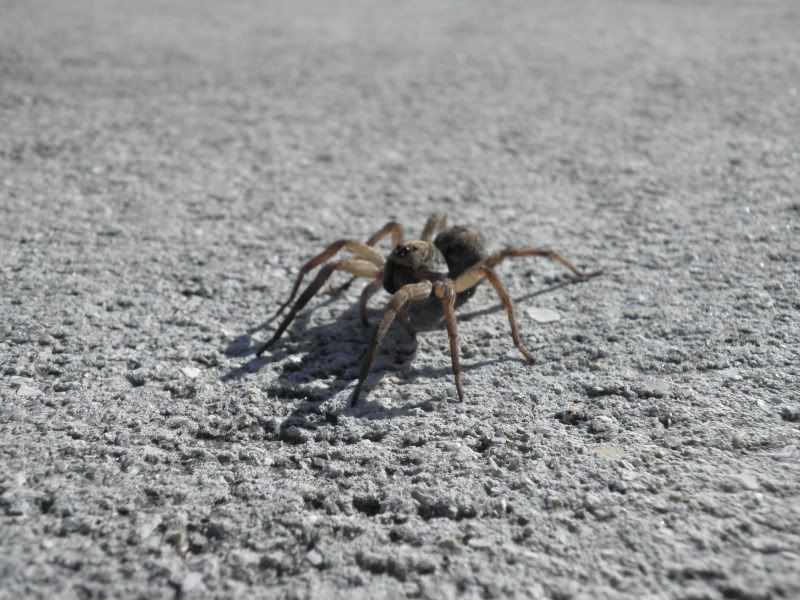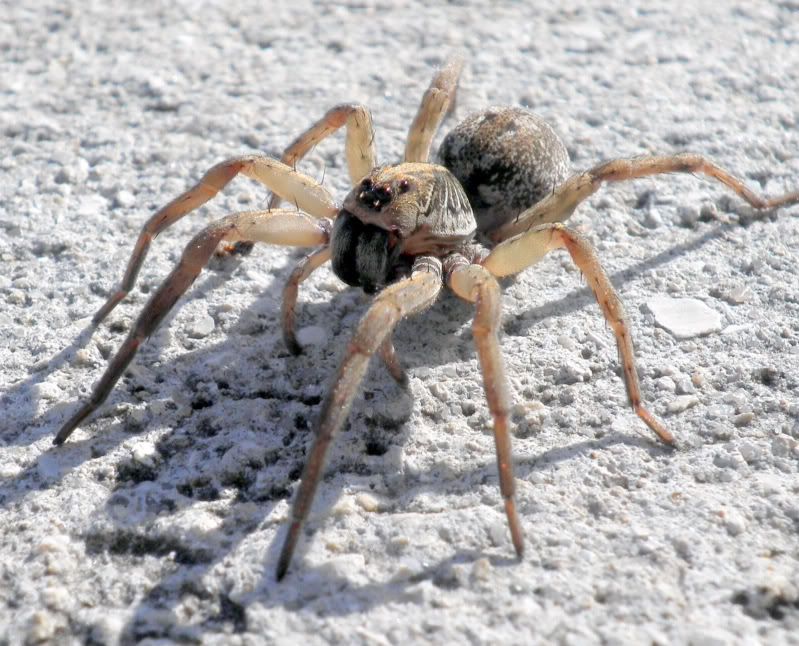Spider Identification
- Thread starter newbieabc
- Start date
meowzer
Moderator
florida joe
Well-Known Member
come on guy living in Florida you have to know your spiders. Its a wolf spider native to the state
meowzer
Moderator
Originally Posted by reefraff
http:///forum/post/3198674
Spotious Greasyious if I came across it at my house.
 yup...that thing would have been under a brick before I had time to grab a camera
yup...that thing would have been under a brick before I had time to grab a camera
http:///forum/post/3198674
Spotious Greasyious if I came across it at my house.

cranberry
Active Member
Originally Posted by reefraff
http:///forum/post/3198674
spotious greasyious if i came across it at my house.
lol! Bahahahahahahahahahahahaha!
*wipes laughter tear*
http:///forum/post/3198674
spotious greasyious if i came across it at my house.
lol! Bahahahahahahahahahahahaha!
*wipes laughter tear*
meowzer
Moderator
Originally Posted by newbieABC
http:///forum/post/3198683
I was thinking brown recluse also.
Wolf spider, huh?
Heres another picture to determine the size, i'm not sure what to compare it to...

WHy don;t you just put your hand next to it

Or seriously...put somthing on the ground that we know the size of
http:///forum/post/3198683
I was thinking brown recluse also.
Wolf spider, huh?
Heres another picture to determine the size, i'm not sure what to compare it to...

WHy don;t you just put your hand next to it

Or seriously...put somthing on the ground that we know the size of
florida joe
Well-Known Member
allow me once again, Its a Florida wolf spider
meowzer
Moderator
Originally Posted by florida joe
http:///forum/post/3198712
allow me once again, Its a Florida wolf spider
OK...so is that a GOOD spider ....or a BAD spider

we already know it's an ugly spider LOL
http:///forum/post/3198712
allow me once again, Its a Florida wolf spider
OK...so is that a GOOD spider ....or a BAD spider

we already know it's an ugly spider LOL
florida joe
Well-Known Member
FYI The most recognized feature of the Brown Recluse spider is violin pattern on the top side of the spider near the head. Thus they have been nick named the Fiddleback Spider.
nw2salt08
Active Member
Originally Posted by reefraff
http:///forum/post/3198719
I had a cousin who was scared crapless of spiders and then some. I watched him nearly catch his house on fire using a can of spray paint and cigarette lighter to lay waste to a small nest of spiders. Left a nice charcoal spot on the wall.
 That would be me. I'm horrified by them. Just the pics on here caused me to scream. I hate spiders!!!! Good thing I haven't had to deal with them while my husband is overseas. lol I make my dad come over and spray the house every 3 months on the dot with Demon WP. Haven't seen a bug in here other than a fly or moth.
That would be me. I'm horrified by them. Just the pics on here caused me to scream. I hate spiders!!!! Good thing I haven't had to deal with them while my husband is overseas. lol I make my dad come over and spray the house every 3 months on the dot with Demon WP. Haven't seen a bug in here other than a fly or moth.
http:///forum/post/3198719
I had a cousin who was scared crapless of spiders and then some. I watched him nearly catch his house on fire using a can of spray paint and cigarette lighter to lay waste to a small nest of spiders. Left a nice charcoal spot on the wall.

florida joe
Well-Known Member
Originally Posted by meowzer
http:///forum/post/3198717
OK...so is that a GOOD spider ....or a BAD spider

we already know it's an ugly spider LOL
Size:
Range from ½ to 2-inches in length.
Behavior:
Most wolf spiders have stout bodies and long, thick legs. Their bodies are low to the ground even when walking or running, giving them the appearance of continually being on the prowl. As skilled daytime hunters, their dull coloring helps to camouflage them as they hunt along the ground. “Wolf spider” is a common name for any of a group of ground-dwelling hunting spiders that are not associated with webs. There are more than 2000 species and are large enough to sometimes be mistaken with tarantulas.
The hunting strategies of Florida wolf spiders are perhaps the most diverse of any spider group. Many are active, wandering hunters during the day in sunny areas along the ground and in vegetation; others hunt at night and remain in silk-lined “retreats” during the day. Others live and hunt in aquatic environments, walking on the surface of ponds or on submerged vegetation. Some wolf spiders dig burrows in which they lie in wait for passing insects and other prey. Of the Florida spiders that dig burrows, some add a moveable trap door at the burrow entrance while others build an elevated lookout point.
The female wolf spider lays eggs in a large sac, which can often be as large as her own body. She attaches the egg sac to her body, and carries it with her until the eggs hatch. She then tears open the egg sac and the newly hatched spiders climb onto her back where they remain for up to a week. They do not usually breed indoors or in homes.
Habitat:
Wolf spiders are commonly found in gardens, leaf litter and areas of tall grass where they patrol the ground for insects, and similar prey, though they can be found in a variety of habitats. They may also dwell under stones and logs, preferring covered, hidden areas. Wolf spiders are rarely pests, and usually enter structures underneath doors or through cracks in the exterior walls where their size can frighten some.
Bite Signs and Symptoms:
Wolf spiders are not poisonous, and will typically bite only when handled. As with most spiders bites, they may cause reactions in certain individuals.
http:///forum/post/3198717
OK...so is that a GOOD spider ....or a BAD spider

we already know it's an ugly spider LOL
Size:
Range from ½ to 2-inches in length.
Behavior:
Most wolf spiders have stout bodies and long, thick legs. Their bodies are low to the ground even when walking or running, giving them the appearance of continually being on the prowl. As skilled daytime hunters, their dull coloring helps to camouflage them as they hunt along the ground. “Wolf spider” is a common name for any of a group of ground-dwelling hunting spiders that are not associated with webs. There are more than 2000 species and are large enough to sometimes be mistaken with tarantulas.
The hunting strategies of Florida wolf spiders are perhaps the most diverse of any spider group. Many are active, wandering hunters during the day in sunny areas along the ground and in vegetation; others hunt at night and remain in silk-lined “retreats” during the day. Others live and hunt in aquatic environments, walking on the surface of ponds or on submerged vegetation. Some wolf spiders dig burrows in which they lie in wait for passing insects and other prey. Of the Florida spiders that dig burrows, some add a moveable trap door at the burrow entrance while others build an elevated lookout point.
The female wolf spider lays eggs in a large sac, which can often be as large as her own body. She attaches the egg sac to her body, and carries it with her until the eggs hatch. She then tears open the egg sac and the newly hatched spiders climb onto her back where they remain for up to a week. They do not usually breed indoors or in homes.
Habitat:
Wolf spiders are commonly found in gardens, leaf litter and areas of tall grass where they patrol the ground for insects, and similar prey, though they can be found in a variety of habitats. They may also dwell under stones and logs, preferring covered, hidden areas. Wolf spiders are rarely pests, and usually enter structures underneath doors or through cracks in the exterior walls where their size can frighten some.
Bite Signs and Symptoms:
Wolf spiders are not poisonous, and will typically bite only when handled. As with most spiders bites, they may cause reactions in certain individuals.



